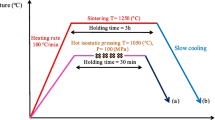Abstract
Arc melting with nonconsumable tungsten electrode and water-cooled copper crucible was used to fabricate Ti–Cu binary alloys with different Cu contents in an argon atmosphere. The compositions and phase structures of the fabricated alloys were investigated by glow discharge optical emission spectroscopy (GDOES) and X-ray diffraction (XRD). Nanoindentation tests through continuous stiffness measurement were then performed at room temperature to analyze the mechanical behaviors of the alloys. Results indicated that the composition of each Ti–Cu binary alloy was Ti(100−x) Cu x (x = 43, 60, 69, and 74 at.%). The XRD analysis results showed that the alloys were composed of different phases, indicating that different Cu contents led to the variations in alloy hardness. The wear tests results revealed that elemental Cu positively affects the wear resistance properties of the Ti–Cu alloys. Nanoindentation testing results showed that the moduli of the Ti–Cu alloys were minimally changed at increasing Cu content, whereas their hardness evidently increased according to the wear test results.











Similar content being viewed by others
References
C.F. Marcinak, F.A. Young, M. Spector, J. Dent. Res 59, 472 (1980)
M. Kikuchi, Y. Takada, S. Kiyosue, et al. Dent. Mater. 19, 174(2003).
M. Taira, J.B. Moser, E.H. Greener, Dent. Mater. 5, 45 (1989).
T.B. Massalski, J.L. Murray, L.H. Bennett, et al., in Binary alloy phase diagrams, ed. by H. Baker (ASM International, Metals Park, Ohio, 1987) p. 180.
G. Lütjering, S. Weissmann, Metall. Mater. Trans. 1, 1641 (1970).
S. Nagarjuna, M. Srinivas, K. Balasubramanian, et al. Math. Sci. Eng. A—Struct. 259, 34(1999).
A.O.F. Hayama, P.N. Andrade, A. Cremasco et al., Mater. Des. 55, 1006 (2014)
Y.Q. Zhao, W.L. Wu, H. Chang, Math. Sci. Eng. A—Struct. 416, 181(2006).
C. Ohkubo, I. Shimura, T. Aoki et al., Biomaterials 24, 3377 (2003)
W.R. Osório, A. Cremasco, P.N. Andrade et al., Electrochim. Acta 55, 759 (2010)
M. Kikuchi, M. Takahashi, O. Okuno. Dent. Mater. 22, 641 (2006).
J. Liu, F. Li, E. Zhang, et al. Math. Sci. Eng. C—Mater. 35, 392 (2014).
E. Zhang, L. Zheng, J. Liu, et al. Mat. Sci. Eng. C—Mater. 46, 148 (2015).
E. Zhang, F. Li, H. Y. Wang, et al. Math. Sci. Eng. C—Mater. 33, 4280 (2013).
E. Zhang, X. Wang, M. Chen, et al. Mat. Sci. Eng. C—Mater. 69, 1210 (2016)
W.C. Oliver, G.M. Pharr, J. Mater. Res. 7, 1564 (1992)
J.B. Pethica, W.C. Oliver, Phys. Scripta. 1987, 61 (2007)
G.M. Pharr, W.C. Oliver, F.R. Brotzen, J. Mater. Res. 7, 613 (1992)
E. Pellicer, A. Varea, S. Pané et al., Adv. Funct. Mater 20, 983 (2010)
F. Yang, K. Geng, P.K. Liaw et al., Acta Mater 55, 321 (2007)
J. Musil, F. Kunc, H. Zeman, et al. Surf. Coat. Tech. 154, 304 (2002).
J. Fornell, S. González, E. Rossinyol et al., Acta Mater 58, 6256 (2010)
A. Leyland, A. Matthews, Wear, 246, 1 (2000).
C. Rebholz, A. Leyland, J. M. Schneider, et al. Surf. Coat. Tech. 120, 412 (1999).
M. Dao, L. Lu, R.J. Asaro, et al. Acta. Mater. 55, 4041 (2007).
Acknowledgements
This work is supported by the National Natural Science Foundation of China (Grant No. 11172195).
Author information
Authors and Affiliations
Corresponding author
Rights and permissions
About this article
Cite this article
Yu, F., Wang, H., Yuan, G. et al. Effect of Cu content on wear resistance and mechanical behavior of Ti–Cu binary alloys. Appl. Phys. A 123, 278 (2017). https://doi.org/10.1007/s00339-017-0921-6
Received:
Accepted:
Published:
DOI: https://doi.org/10.1007/s00339-017-0921-6




